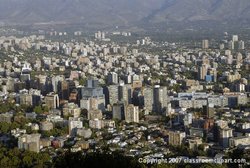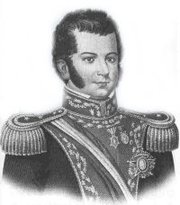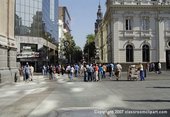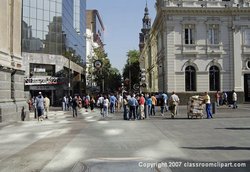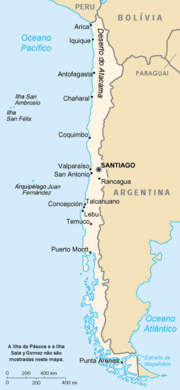Chile
|
|
The Republic of Chile is a country in South America occupying a long coastal strip between the Andes mountains and the Pacific Ocean. It shares borders with Argentina to the east, Bolivia to the northeast and Peru to the north.
| |||||
| Motto: Por la razón o la fuerza (Spanish: "By right or might") | |||||
| Anthem: Himno Nacional | |||||
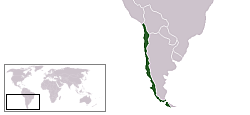
| |||||
| Capital | Santiago1 Template:Coor dm | ||||
| Largest city | Santiago | ||||
| Official languages | Spanish | ||||
| Government | Democratic republic Ricardo Lagos | ||||
| Independence • Initiated • Declared | From Spain September 18, 1810 February 12, 1818 | ||||
| Area • Total • Water (%) | 756,9502 km² (38th) 1.07% | ||||
| Population • June 2005 est. • 2002 census • Density | 16,136,137 (60th) 15,116,435 21/km² (153rd) | ||||
| GDP (PPP) • Total • Per capita | 2005 estimate $186,733 million (45th) $11,537 (59th) | ||||
| Currency | Peso (CLP)
| ||||
| Time zone • Summer (DST) | — (UTC-4) — (UTC-3) | ||||
| Internet TLD | .cl | ||||
| Calling code | +56
| ||||
| 1 The legislative body operates in Valparaíso 2 Includes Easter Island and Isla Sala y Gómez; does not include 1,250,000 km² of claimed territory in Antarctica | |||||
| Contents |
Origin of the name
There are various theories about the origin of the word Chile. According to one theory the Incas of Peru, who had failed to conquer the Araucanians, called the valley of the Aconcagua "Chili" by corruption of the name of a tribal chief ("cacique") called Tili, who ruled the area at the time of the Incan conquest. Another theory points to the similarity of the valley of the Aconcagua with that of the Casma in Peru, where there was a town and valley named Chili. Other theories say Chile may derive its name from the indigenous Mapuche word chilli, which may mean "where the land ends" or "the deepest point of the Earth," or from the Aimara tchili meaning "snow"; another meaning attributed to chilli is the onomatopoeic cheele-cheele—the Mapuche imitation of a bird call. The Spanish conquistadors heard about this name from the Incas and the few survivors of Diego de Almagro's first Spanish expedition south from Peru in 1535-36 called themselves the "men of Chilli."
History
Main article: History of Chile
About 10,000 years ago, migrating Native Americans settled in fertile valleys and along the coast of what is now Chile. The Incas briefly extended their empire into what is now northern Chile, but the area's remoteness prevented extensive settlement.
The first Europeans to arrive in Chile were Diego de Almagro and his band of Spanish conquistadors, who came from Peru in 1535 seeking gold but were turned back by the local population. The Spanish encountered hundreds of thousands of Indians from various cultures in the area that modern Chile now occupies. These cultures supported themselves principally through slash-and-burn agriculture and hunting. The first permanent European settlement, Santiago, was founded in 1541 by Pedro de Valdivia, one of Francisco Pizarro's lieutenants. Although the Spanish did not find the extensive gold and silver they sought, they recognized the agricultural potential of Chile's central valley, and Chile became part of the Viceroyalty of Peru.
Conquest of the land that is today called Chile took place only gradually, and the Europeans suffered repeated setbacks at the hands of the local population. A massive Mapuche insurrection that began in 1553 resulted in Valdivia's death and the destruction of many of the colony's principal settlements. Subsequent major insurrections took place in 1598 and in 1655. Each time the Mapuche and other native groups revolted, the southern border of the colony was driven northward. The abolition of slavery in 1683 defused tensions on the frontier between the colony and the Mapuche land to the south, and permitted increased trade between colonists and Mapuches.
The drive for independence from Spain was precipitated by usurpation of the Spanish throne by Napoleon's brother Joseph. A national junta in the name of Ferdinand—heir to the deposed king—was formed on September 18, 1810. The junta proclaimed Chile an autonomous republic within the Spanish monarchy. A movement for total independence soon won a wide following. Spanish attempts to reimpose arbitrary rule during what was called the Reconquista led to a prolonged struggle.
Intermittent warfare continued until 1817, when an army led by Bernardo O'Higgins, Chile's most renowned patriot, and José de San Martín, hero of Argentine independence, crossed the Andes into Chile and defeated the royalists. On February 12, 1818, Chile was proclaimed an independent republic under O'Higgins' leadership. The political revolt brought little social change, however, and 19th century Chilean society preserved the essence of the stratified colonial social structure, which was greatly influenced by family politics and the Roman Catholic Church. The system of presidential absolutism eventually predominated, but wealthy landowners continued to control Chile.
Toward the end of the 19th century, the government in Santiago consolidated its position in the south by ruthlessly suppressing the Mapuche Indians, finally completing the conquest begun more than three centuries earlier. In 1881, the government signed a treaty with Argentina confirming Chilean sovereignty over the Strait of Magellan. As a result of the War of the Pacific with Peru and Bolivia (1879-83), Chile expanded its territory northward by almost one-third and acquired valuable nitrate deposits, the exploitation of which led to an era of national affluence. Chile established a parliamentary style democracy in the late 19th century, but degenerated into a system protecting the interests of the ruling oligarchy. By the 1920s, the emerging middle and working classes were powerful enough to elect a reformist president, whose program was frustrated by a conservative congress. In the 1920s, Marxist groups with strong popular support arose.
A military coup led by General Luis Altamirano in 1924 set off a period of great political instability that lasted until 1932. The longest lasting of the ten governments between those years was that of General Carlos Ibáñez, who briefly held power in 1925 and then again between 1927 and 1931 in what was a de facto dictatorship. When constitutional rule was restored in 1932, a strong middle-class party, the Radicals, emerged. It became the key force in coalition governments for the next 20 years. During the period of Radical Party dominance (1932-52), the state increased its role in the economy. In 1952, voters returned Ibáñez to office for another 6 years. Jorge Alessandri succeeded Ibáñez in 1958.
The 1964 presidential election of Christian Democrat Eduardo Frei Montalva by an absolute majority initiated a period of major reform. Under the slogan "Revolution in Liberty," the Frei administration embarked on far-reaching social and economic programs, particularly in education, housing, and agrarian reform, including rural unionization of agricultural workers. By 1967, however, Frei encountered increasing opposition from leftists, who charged that his reforms were inadequate, and from conservatives, who found them excessive. At the end of his term, Frei had accomplished many noteworthy objectives, but he had not fully achieved his party's ambitious goals.
In 1970, Senator Salvador Allende Gossens, a Marxist physician and member of Chile's Socialist Party, who headed the "Popular Unity" (UP or "Unidad Popular") coalition of the Socialist, Communist, Radical, and Social-Democratic Parties, along with dissident Christian Democrats, the Popular Unitary Action Movement (MAPU), and the Independent Popular Action, won a plurality of votes in a three-way contest. The Chilean Congress conducted a runoff vote between the leading candidates, Allende and former president Jorge Alessandri and chose Allende by a vote of 153 to 35.
Allende's program included advancement of workers' interests; a thoroughgoing implementation of agrarian reform; the reorganization of the national economy into socialized, mixed, and private sectors; a foreign policy of "international solidarity" and national independence; and a new institutional order (the "people's state" or "poder popular"), including the institution of a unicameral congress. The Popular Unity platform also called for nationalization of foreign (U.S.) ownership of Chile's major copper mines.
An economic depression that began in 1967 peaked in 1970, exacerbated by capital flight, plummeting private investment, and withdrawal of bank deposits by those opposed to Allende's socialist program. Production fell and unemployment rose. Allende adopted measures including price freezes, wage increases, and tax reforms, which had the effect of increasing consumer spending and redistributing income downward. Joint public-private public works projects helped reduce unemployment. Much of the banking sector was nationalized. Many enterprises within the copper, coal, iron, nitrate, and steel industries were expropriated, nationalized, or subjected to state intervention. Industrial output increased sharply and unemployment fell during the Allende administration's first year.
Other reforms undertaken during the early Allende period included redistribution of millions of hectares of land to landless agricultural workers as part of the agrarian reform program, giving the armed forces an overdue pay increase, and providing free milk to children. The Indian Development Corporation and the Mapuche Vocational Institute were founded to address the needs of Chile's indigenous population.
The nationalization of U.S. and other foreign-owned companies led to increased tensions with the United States. The Nixon administration brought international financial pressure to bear in order to restrict economic credit to Chile. Simultaneously, the CIA funded opposition media, politicians, and organizations, helping to accelerate a campaign of domestic destabilization. By 1972, the economic progress of Allende's first year had been reversed and the economy was in crisis. Political polarization grew, and large mobilizations of both pro- and anti-government groups became frequent, often leading to clashes.
By early 1973, inflation was out of control. The crippled economy was further battered by prolonged and sometimes simultaneous strikes by physicians, teachers, students, truck owners, copper workers, and shop owners. A military coup backed by the CIA overthrew Allende on September 11, 1973. As the armed forces bombarded the presidential palace (Palacio de La Moneda), Allende reportedly committed suicide. A military government, led by General Augusto Pinochet Ugarte, took over control of the country. The first years of the regime were marked by serious human rights violations. A new Constitution was approved by a plebiscite on September 11, 1980, and General Pinochet became President of the Republic for an 8-year term. In its later years, the regime gradually permitted greater freedom of assembly, speech, and association, to include trade union and political activity. In contrast to its authoritarian political rule, the military government pursued decidedly laissez-faire economic policies. During its nearly 17 years in power, Chile moved away from economic statism toward a largely free market economy that fostered an increase in domestic and foreign private investment. In a plebiscite on October 5, 1988, General Pinochet was denied a second 8-year term as president. Chileans elected a new president and the majority of members of a two-chamber congress on December 14, 1989. Christian Democrat Patricio Aylwin, the candidate of a coalition of 16 political parties called the Concertación, received an absolute majority of votes. President Aylwin served from 1990 to 1994.
In December 1993, Christian Democrat Eduardo Frei Ruiz-Tagle, the son of previous president Eduardo Frei Montalva, led the Concertación coalition to victory with an absolute majority of votes. President Frei's administration was inaugurated in March 1994.
A presidential election was held on December 12, 1999, but none of the six candidates obtained a majority, which led to an unprecedented runoff election on January 16, 2000. Ricardo Lagos Escobar of the Socialist Party led the Concertación coalition to a narrow victory, with 51.31% of the votes. He was sworn in March 11, 2000, for a 6-year term.
Politics
Main article: Politics of Chile
Chile's Constitution was approved in a September 1980 national plebiscite. It entered into force in March 1981. After Pinochet's defeat in the 1988 plebiscite, the Constitution was amended to ease provisions for future amendments to the Constitution. Many among Chile's political class see further constitutional reform as necessary to complete the transition to democracy. Reforms that are currently under consideration include the abolition of non-elected Senators (institutional senators, or senators for life) and securing the Presidential right to remove the Commander in Chief of the Armed Forces. A number of these reforms have been approved by the Senate and are awaiting action by the lower house.
Chile's bicameral Congress has a 48-seat Senate--38 elected, 9 appointed, 1 for life--and a 120-member Chamber of Deputies. Deputies are elected every 4 years. Senators serve for 8 years with staggered terms. The current Senate is evenly split 24-24 between pro-government and opposition Senators. Nine institutional senators were appointed in 1999, and two "senators for life," former Presidents Pinochet (who resigned in 2002) and Frei. (Chile's Constitution provides that former presidents who have served at least 6 years shall be entitled to a lifetime senate seat.) The last congressional elections were held in December 2001. The current lower house?the Chamber of Deputies?contains 60 members of the governing center-left coalition and 56 from the center-right opposition. Currently 4 Deputies have their voting rights suspended on legal grounds. The Congress is located in the port city of Valpara�, about 140 kilometers (84 mi.) west of the capital, Santiago.
Chile's congressional elections are governed by a unique binomial system that rewards coalition slates. Each coalition can run two candidates for the two Senate and two lower chamber seats apportioned to each chamber's electoral districts. Typically, the two largest coalitions split the seats in a district. Only if the leading coalition ticket out-polls the second-place coalition by a margin of more than 2-to-1 does the winning coalition gain both seats. In the 2001 congressional elections, the conservative Independent Democratic Union surpassed the Christian Democrats for the first time to become the largest party in the lower house. The Communist Party again failed to gain any seats in the 2001 elections.
The next presidential and congressional elections are set for December 2005.
Chile's judiciary is independent and includes a court of appeal, a system of military courts, a constitutional tribunal, and the Supreme Court. Chile will complete in mid-2005 a multi-year overhaul of its criminal justice system. The reform has replaced inquisitorial proceedings with an adversarial system more similar to that of the United States.
Regions
Main article: Regions of Chile
Chile is divided into 13 regions, each of which is headed by an intendente. Every region is further divided into provinces with a Gobernador Provincial. Finally each province is divided into various Comunas each with its own mayor. Intendentes and gobernadores are appointed by the president, mayors are elected by popular vote.
Each region is designated by a name and a Roman numeral. Numbers are assigned from north to south. In general the Roman numeral is used, rather than the name. The only exception is the region where Santiago is situated, which is designated RM, that stands for Región Metropolitana, Metropolitan Region.
Geography
Main article: Geography of Chile
A long and narrow coastal region on the west side of the Andes Mountains, Chile stretches over 4,630 km (2,880 miles) north to south, but only 430 km (265 mi) at its widest point east to west.
The northern Atacama desert contains great mineral wealth, primarily copper and nitrates. The relatively small Central Valley, which includes Santiago, dominates the country in terms of population and agricultural resources. This area also is the historical center from which Chile expanded in the late 19th century, when it integrated the northern and southern regions. Southern Chile is rich in forests and grazing lands and features a string of volcanoes and lakes. The southern coast is a labyrinth of fjords, inlets, canals, twisting peninsulas, and islands. The Andes Mountains are located on the eastern border.
Chile is the longest (N-S) country in the world (over 4,200km), and also claims a large section of Antarctica as part of its territory.
Chile controls Easter Island, the easternmost island of Polynesia, which it incorporated to its territory in 1888, and Robinson Crusoe Island, some 400 km from the mainland, in the Juan Fernᮤez archipelago.
Economy
Main article: Economy of Chile
After a decade of impressive growth rates, Chile experienced a moderate downturn in 1999 brought on by the global economic slowdown. The economy remained sluggish until 2003, when it began to show clear signs of recovery, achieving 3.3% real GDP growth. The Chilean economy finished 2004 with growth of 6.1%. Most experts expect GDP growth of around 6% in 2005.
Chile has pursued generally sound economic policies for nearly three decades. The 1973-90 military government sold many state-owned companies, and the three democratic governments since 1990 have continued privatization at a slower pace. The government's role in the economy is mostly limited to regulation, although the state continues to operate copper giant Codelco and a few other enterprises. Chile is strongly committed to free trade and has welcomed large amounts of foreign investment. Chile has signed Free Trade agreements with several important economies, including an FTA with the United States, which was signed in 2003 and implemented in January 2004. High domestic savings and investment rates also helped propel Chile's economy to average growth rates of 8% during the 1990s. The privatized national pension system has encouraged domestic investment and contributed to an estimated total domestic savings rate of approximately 21% of GDP in 2003.
Unemployment has hovered in the 8%-10% range in recent years, well above the 5%-6% average for the 1990s. Unemployment remained at 8.8% at the end of 2004 in spite of strong economic growth. Wages have risen faster than inflation as a result of higher productivity, boosting national living standards. The share of Chileans with incomes below the poverty line--defined as twice the cost of satisfying a person's minimal nutritional needs--fell from 46% of the population in 1987 to 18.8% in 2003.
Chile's independent Central Bank pursues a policy of maintaining inflation between 2% and 4%. Inflation has not exceeded 5% since 1998. Chile registered inflation of 2.4% in 2004 and is expected to see a 2.5% increase in 2005. Most wage settlements and spending decisions are indexed, reducing inflation's volatility. Under the compulsory private pension system, most formal sector employees pay 10% of their salaries into privately managed funds.
Total foreign direct investment rose to $7.1 billion in 2004, up from $2.5 billion in 2003. Both foreign and domestic investment in Chile had declined during the country?s period of slower economic growth from 1999-2003, but appear to be recovering strongly. The Chilean Government committed in early 2002 to undertake a series of microeconomic reforms designed to create new incentives for private investment. The government also has encouraged the use of Chile as an "investment platform" for multinational corporations planning to invest in the region. Chile's welcoming attitude toward foreign direct investment is codified in the country's Foreign Investment Law, which gives foreign investors the same treatment as Chileans. Registration is simple and transparent, and foreign investors are guaranteed access to the official foreign exchange market to repatriate their profits and capital. The U.S.-Chile Free Trade Agreement (FTA) offers a number of other investor protections.
Foreign Trade
Chile's economy is highly dependent on international trade. In 2004, exports accounted for about 34% of GDP. Chile has traditionally been dependent upon copper exports; the state-owned firm CODELCO is the world's largest copper-producing company. Nontraditional exports have grown faster than those of copper and other minerals. In 1975, non-mineral exports made up just over 30% of total exports, whereas now they account for about 60%. The most important non-mineral exports are forestry and wood products, fresh fruit and processed food, fishmeal and seafood, and wine. The trade balance for 2004 showed a historic surplus $9 billion, considerably higher than 2003. Total exports in 2004 were $32 billion, a 52.1% increase from $20.4 billion in 2003. Chile's export markets are fairly balanced among Europe (25.1%), Asia (33.1%), Latin America (15.7%), and North America (19%). The U.S., the largest national market, takes in 17.3% of Chile's exports. Asia has been the fastest-growing export market in recent years.
Chilean imports increased 30% in 2004, to $23 billion, reflecting a positive change in consumer demand and economic recovery. Capital goods made up about 66% of total imports. The United States represented 14.6% of Chilean imports in 2004. As a bloc, the EU in 2004 supplied 16.3% of Chile's imports, while Argentina contributed 16%. Chile unilaterally lowered its across-the-board import tariff--for all countries with which it does not have a trade agreement--to 6% in 2003.
Higher effective tariffs are charged only on imports of wheat, wheat flour, and sugar as a result of a system of import price bands. The price bands were ruled inconsistent with Chile's WTO obligations in 2002 and the government has introduced legislation to modify them. Chile will have to phase out the price bands within 12 years under the terms of the U.S.-Chile FTA.
Successive Chilean governments have actively pursued liberalizing trade agreements. During the 1990's, Chile signed FTA's with Canada, Mexico, and Central America. Chile also concluded preferential trade agreements with Venezuela, Colombia, and Ecuador. An association agreement with Mercosur--Argentina, Brazil, Paraguay, and Uruguay--went into effect in October 1996. Chile, a member of the Asia-Pacific Economic Cooperation (APEC) organization, is seeking to boost commercial ties to Asian markets. Continuing its export-oriented development strategy, Chile completed landmark free trade agreements in 2002 with the European Union and South Korea. After two years of negotiations, the United States and Chile signed an agreement in June 2003. The agreement will lead to completely duty free bilateral trade within 12 years. The U.S.-Chile FTA entered into force January 1, 2004 following approval by the U.S and Chilean congresses. Chile is a strong proponent of pressing ahead on negotiations for a Free Trade Area of the Americas (FTAA). Chile is currently negotiating trade agreements with China and India, as well as a tri-partite agreement with Singapore and New Zealand.
Finance
Chile's financial sector has grown faster than other areas of the economy over the last few years; a banking reform law approved in 1997 broadened the scope of permissible foreign activity for Chilean banks. The Chilean Government implemented a further liberalization of capital markets in 2001. Chileans have enjoyed the recent introduction of new financial tools such as home equity loans, currency futures and options, factoring, leasing, and debit cards. The introduction of these new products has been accompanied by increased use of traditional instruments such as loans and credit cards. Chile's private pension system, with assets worth roughly $54 billion in late 2004, has provided an important source of investment capital for the capital market. Chile maintains one of the best credit ratings (S+P A+) in Latin America. There are three main ways Chilean firms raise funds abroad: bank loans, issuance of bonds, and the selling of stock on U.S. markets through American Depository Receipts (ADR's). Nearly all of the funds raised go to finance investment. The government is paying down its foreign debt. The combined public and private foreign debt was roughly over 50% of GDP at the end of 2004--low by Latin American standards.
Defense
Main article: Military of Chile
Chile's Armed Forces are subject to civilian control exercised by the President through the Minister of Defense. Under the 1980 Constitution, the services enjoy considerable autonomy, and the President cannot remove service commanders on his own authority.
Army
The commander in chief of the Chilean Army is Maj. Gen. Juan Emilio Cheyre. The Chilean Army is 45,000 strong and is organized with an Army headquarters in Santiago, seven divisions throughout its territory, an Air Brigade in Rancagua, and a Special Forces Command in Colina. The Chilean Army is one of the most professional and technologically advanced armies in Latin America.
Navy
Adm. Rodolfo Codina D� directs the 25,000-person Navy, including 5,000 Marines. Of the fleet of 29 surface vessels, only six are operational major combatants (destroyers and frigates). Those ships are based in Valpara�. The Navy operates its own aircraft for transport and patrol; there are no Navy fighter or bomber aircraft. The Navy also operates three submarines based in Talcahuano.
Air Force (FACH)
Gen. Osvaldo Sarabia heads a force of 12,500. Air assets are distributed among five air brigades headquartered in Iquique, Antofagasta, Santiago, Puerto Montt, and Punta Arenas. The Air Force also operates an airbase on King George Island, Antarctica. The FACH will begin taking delivery of 10 U.S. F-16 aircraft in 2006.
Carabineros
After the military coup in September 1973, the Chilean national police (Carabineros) were incorporated into the Defense Ministry. With the return of democratic government, the police were placed under the operational control of the Interior Ministry but remained under the nominal control of the Defense Ministry. Gen. Alberto Cienfuegos is the head of the national police force of 30,000 men and women who are responsible for law enforcement, traffic management, narcotics suppression, border control, and counter-terrorism throughout Chile.
Foreign relations
Since its return to democracy in 1990, Chile has been an active participant in the international political arena. Chile completed a 2-year non-permanent position on the UN Security Council in January 2005. Chile is an active member of the UN family of agencies and participates in UN peacekeeping activities. Chile hosted the Defense Ministerial of the Americas in 2002 and the APEC summit and related meetings in 2004. Chile hosted the Community of Democracies ministerial in April 2005. An associate member of Mercosur and a full member of APEC, Chile and has been an important actor on international economic issues and hemispheric free trade.
The Chilean Government has diplomatic relations with most countries. It settled its territorial disputes with Argentina during the 1990s. Chile and Bolivia severed diplomatic ties in 1978 over Bolivia's desire to reacquire territory it lost to Chile in 1879-83 War of the Pacific. The two countries maintain consular relations.
Demographics
Main article: Demographics of Chile
Around 95% of Chileans descend from early Spanish colonists. During the colonial period, Spain found it necessary to keep sending soldiers to protect its distant colony. They came from all regions of Spain, including the Basque country, and many of them ended up settling in Chile. The combination of an economy based on temperate-zone agriculture, native American resistance to Spanish occupation, and a continuous influx of Spaniards from the mid-sixteenth century to the end of the colonial period defined the main body of the Chilean population ? a mixture of native American and Spanish blood, but one in which the Spanish element is greater than in the other Andean mestizo populations. People of relatively unmixed Spanish ancestry are not uncommon.
People self-identifying as belonging to indigenous groups number around 700,000 (5%) and are mostly Mapuche (4%) that reside in the south-central area of the country. Aymara and [[Atacame populations live along the northern border with Peru and Bolivia. There are also around 5,000 people of Polynesian ancestry who are indigenous to the Chilean territory of Easter Island (Rapanui) in the Pacific.
Chileans descended from non-Spanish European nationalities are not too numerous, but include a small yet influential number of Irish and English immigrants that arrived in Chile during the Spanish colonial period, and during the 19th century. Government-sponsored immigration from Germany began in 1848, and in time, changed the cultural makeup of the southern provinces of Valdivia, Llanquihue, and Osorno, which still show a strong German influence. Other historically significant immigrant groups include people of Italian (Valpara�), Croatian (Antofagasta and Punta Arenas), French, and Middle Eastern backgrounds (including the second largest Palestinian colony outside Middle East).
In the last decade there has been an influx of Koreans who settled in small sections of Santiago. In recent years, the difficult economic situation in neighbouring Peru and Argentina has resulted in work-related trans-Andean migration to Chile.
Culture
Main article: Culture of Chile
Chile was an important center of culture in the ancient Inca empire, and was afterwards dominated by the Spanish.
The national dance is the cueca (short for zamacueca) and first appeared in 1824. The tonada is another important form of Chilean traditional song, arising from the music imported by Spanish colonists. It is distinguished from the cueca by an intermediate melodic section and a more prominent melody in general; the tonada is also not danced. In the mid-1960s native musical forms were revitalized by the Parra family with the Nueva Canción Chilena, which became associated with political activism and reformers like Chilean socialist Salvador Allende and his Popular Unity government. Violeta Parra, Víctor Jara, Los Jaivas, Inti-Illimani, Illapu and Quilapayún are exhibitors of this music. During the military dictatorship in the 1970s, all forms of public expression were repressed, and music circulated in a clandestine manner. In the late 1980s and after the return of democracy in the 1990s, new musical bands like La Ley, Los Tres and Los Prisioneros, began to appear. See: Music of Chile
Chileans call their country País de Poetas ("land of poets"). The country has produced two Nobel Literature laureates: Gabriela Mistral and Pablo Neruda. Other major poets include: Vicente Huidobro, Pablo de Rokha, Gonzalo Rojas, Jorge Teillier, Enrique Lihn and Nicanor Parra. Isabel Allende, a novelist, has achieved worldwide success with her stories of magic realism in Latin America. Jorge Edwards, Jos頄onoso and Roberto Bolaño are also notable novelists.
Local film production in Chile is small, although it has been growing lately. Important filmmakers include: Ra?iz (Palomita blanca), Miguel Littin (El chacal de Nahueltoro), Silvio Caiozzi (Julio comienza en julio), Ricardo Larraín (La frontera), Andrés Wood (Machuca) and Alejandro Jodorowsky.
National symbols
The national flower is the copihue (Lapageria rosea, Chilean bellflower), which grows in the woods of southern Chile.
The coat of arms depicts the two national animals: the condor (Vultur gryphus, a very large bird that lives in the mountains) and the huemul (Hippocamelus bisulcus, an endangered white tail deer). It also has the legend Por la razón o la fuerza (By reason or by force).
Miscellaneous topics
- Communications in Chile
- Transportation in Chile
- Elections in Chile
- Foreign relations of Chile
- List of Chileans
- Holidays in Chile
- U.S. intervention in Chile
International rankings
- Heritage Foundation/The Wall Street Journal: 2005 (http://www.heritage.org/research/features/index/) Index of Economic Freedom, ranked 11 out of 155 countries (first in Latin America)
- Save the Children: State of the World's Mothers 2005 (http://www.savethechildren.org/mothers/report_2005/), ranked 17 out of 110 countries (tied with Argentina) (third in Latin America after Costa Rica and Cuba)
- IMD International: World Competitiveness Yearbook 2005 (http://www01.imd.ch/wcy/), ranked 19 out of 60 economies (countries and regions) (first in Latin America)
- Transparency International: Corruption Perceptions Index 2004 (http://www.transparency.org/pressreleases_archive/2004/2004.10.20.cpi.en.html), ranked 20 out of 146 countries (first in Latin America)
- World Economic Forum: Global Competitiveness Report 2004-2005 - Growth Competitiveness Index Ranking (http://www.weforum.org/site/homepublic.nsf/Content/Global+Competitiveness+Programme%5CGlobal+Competitiveness+Report), ranked 22 out of 104 countries (first in Latin America)
- The Economist: The World in 2005 - Worldwide quality-of-life index, 2005 (http://www.economist.com/theworldin/international/displayStory.cfm?story_id=3372495&d=2005), ranked 31 out of 111 countries (first in Latin America)
- A.T. Kearney/Foreign Policy Magazine: Globalization Index 2005 (http://www.atkearney.com/main.taf?p=5,4,1,116), ranked 34 out of 62 countries (second in Latin America after Panama)
- Reporters without borders: Third annual worldwide press freedom index (2004) (http://www.rsf.fr/article.php3?id_article=11715), ranked 42 out of 167 countries (tied with Japan, Namibia and Uruguay) (fourth in Latin America after El Salvador, Dominican Republic and Costa Rica)
- UNDP: Human Development Index 2004 (http://hdr.undp.org/reports/global/2004/), ranked 43 out of 177 countries (second in Latin America after Argentina)
Pictures, Clipart and Illustrations of Chile
Pictures of Chile (http://classroomclipart.com/cgi-bin/kids/imageFolio.cgi?direct=Countries_and_Cities/Chile|thumb|130px|)
References
- Bureau of Western Hemisphere Affairs (http://www.state.gov/r/pa/ei/bgn/1981.htm), United States Department of State, April 2005
- Library of Congress country profile (http://lcweb2.loc.gov/frd/cs/cltoc.html)
- The (CIA) World Factbook: Chile (http://www.cia.gov/cia/publications/factbook/geos/ci.html)
External links
State resources
- Gobierno (http://www.gobiernodechile.cl/) - Government (English version (http://www.chileangovernment.cl/))
- Presidencia (http://www.presidencia.cl/) - Presidency (English version (http://www.presidencyofchile.cl/))
- Ministerio del Interior (http://www.interior.cl/) - Interior Ministry
- Ministerio de Relaciones Exteriores (http://www.minrel.cl/) - Ministry of Foreign Affairs
- Congreso Nacional (http://www.congreso.cl/) - National Congress
- Senado (http://www.senado.cl/) - Senate
- C᭡ra de Diputados (http://www.camara.cl/) - Chamber of Deputies
- Biblioteca del Congreso Nacional (http://www.bcn.cl/) - Library of National Congress
- Poder Judicial (http://www.poderjudicial.cl/) - Judiciary
- Template:Wikitravel
General information
- Several links compiled by LANIC (http://www1.lanic.utexas.edu/la/chile/)
- Chile.com (http://www.chile.com)
- Pictures (http://www.chilephoto.cl/cgi-bin/chilephoto/chilephoto.cgi)
| Countries in South America |
|---|
| Argentina | Bolivia | Brazil | Chile | Colombia | Ecuador | Guyana | Panama | Paraguay | Peru | Suriname | Trinidad and Tobago | Uruguay | Venezuela |
| Dependencies: Falkland Islands | French Guiana |



